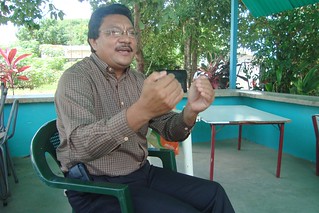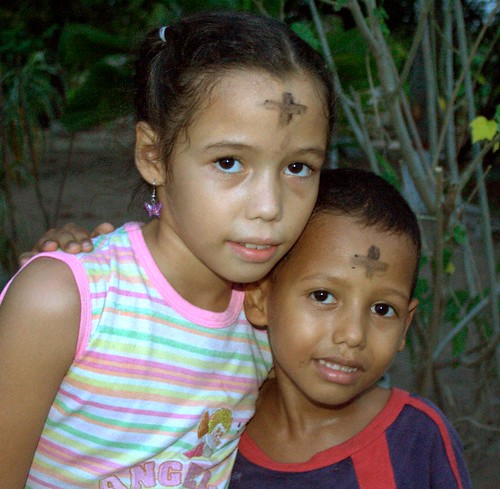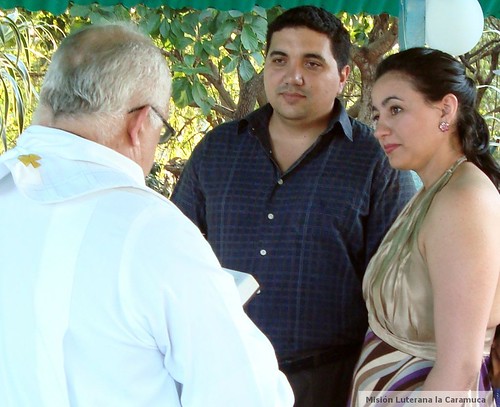 Luz Maria has developed a set of
cards for the historic Lutheran liturgy. The object is to answer correctly as many questions as you can. Her daughter, Charli,
provided the graphic design, while the text on each card was taken,
with the author's permission, from an explanation of the liturgy (in
Spanish) by Edmund Mielke, former missionary to Venezuela and now the
pastor of Grace
Lutheran Church, Brandon, Manitoba. Luz Maria and Charli have put
together 10 sets of these cards with the intention of selling them
for a nominal fee at the national convention of SOLUDAVE (Sociedad
Luterana de Damas Venezolanas), the Venezuelan Lutheran women's
organization. Luz Maria hopes the card game will be used as a tool
for teaching the history and importance of the liturgy in all of the
member congregations of the Lutheran Church of Venezuela.
Luz Maria has developed a set of
cards for the historic Lutheran liturgy. The object is to answer correctly as many questions as you can. Her daughter, Charli,
provided the graphic design, while the text on each card was taken,
with the author's permission, from an explanation of the liturgy (in
Spanish) by Edmund Mielke, former missionary to Venezuela and now the
pastor of Grace
Lutheran Church, Brandon, Manitoba. Luz Maria and Charli have put
together 10 sets of these cards with the intention of selling them
for a nominal fee at the national convention of SOLUDAVE (Sociedad
Luterana de Damas Venezolanas), the Venezuelan Lutheran women's
organization. Luz Maria hopes the card game will be used as a tool
for teaching the history and importance of the liturgy in all of the
member congregations of the Lutheran Church of Venezuela.
Rev. Mielke entitled his treatise
“Oficio Divino” (Divine Office). English-speaking Lutherans
perhaps more often use the expression “Divine Service” in
reference to what the Augsburg Confession continues to call “the
Mass.” According to Article XXIV of the Augsburg Confession,
“Falsely are our churches accused of abolishing the Mass; for the
Mass is retained among us, and celebrated with the highest
reverence.”
The term “Mass” is derived from the
Latin word for dismissal. In the early Christian church, it was
customary, after the preaching, or “service of the Word”, to
dismiss all who were not baptized members of the church and then
celebrate the sacrament of the Lord's Supper. Thus, in the western
half of the Roman Empire, where Latin was adopted as the liturgical
language, the “mass” or dismissal of the unbaptized, at first
signified the beginning of the sacramental service. Later it came to
mean the entire service.
What is called “the Mass” in the
tradition of the western European church is called the “Divine
Liturgy” in the Greek Orthodox churches of eastern Europe and Asia.
“Liturgy” comes from the Greek λειτουργια
(“leitourgia”). This is a compound word combining “leitos” or
public, with “ergon”, which means work or action. Leitourgia
originally meant something provided as a service for the public by a
benefactor of the ruling class. In Spanish, “oficio” can mean
“official function” or “ministry” (the word for what we
usually mean by “office” in English is “oficina”.) In fact,
the word “leitourgia” occurs in the New Testament, where it is
usually translated into English as “service” or “ministry”
(Luke 1:23, 2 Corinthians 9:12, Philippians 2:17, 30, and Hebrews
8:6, 9:21). In Luke 1:23, Zachariah goes home when "the days of
his liturgy” (αι ημεραι της λειτουργιας
αυτου), or service in the Temple, are over.
In the Septuagint (the Greek
translation of the Old Testament read by people who did not know
Hebrew in New Testament times ) the word “leitourgia” (and nouns
and verbs derived from it) is used to translate verses describing the
ritual service of the temple (Numbers 4:24; Joel 1:9, 2:17). In
Hebrews 8:6, the high priest of the New Covenant (Jesus) performs a
better kind of “liturgy” than that of the Old Testament priests
and Levites (νυνι δε διαφορωτερας τετυχεν
λειτουργιας, οσῳ και κρειττονος εστιν
διαθηκης μεσιτης, ητις επι κρειττοσιν
επαγγελιαις νενομοθετηται) by sacrificing
Himself once and for all time for the sins of the whole human race,
and by continuing to act as Mediator between God and man. For this
reason, propitiary sacrifices of animals have been eliminated from
the worship of the New Covenant (because Christ's sacrifice on the
cross covers all sin), as have the ceremonial/ritual purity laws
which had to be obeyed before anyone could enter the Temple and
participate in the Old Testament rites (because we enter the presence
of God made holy by the blood of Christ).
Christ also instituted certain means
for His salvation to be made known to the world and for the
strengthening of the faith of those who believe. First the public
proclamation of the Gospel to the ends of the earth and instruction
in the doctrines of the faith (John 20:21-23, Matthew 28:19-20), and
the sacraments of baptism (Matthew 28:19-20) and the Lord's Supper (1
Corinthians 11:23-24).
By “Divine Service,” “Divine
Liturgy” or “Divine Office”, we mean the public preaching of
the Word, which Christ Himself instituted for the benefit of
believers and those who have yet to believe, and the administration
of the sacraments, baptism for the receiving of people into the
household of faith, and Holy Communion for the strengthening of faith
in those who believe.
Article V of the Augsburg Confession
states, "To obtain such faith, God instituted the preaching
office to give Gospel and Sacraments. Through these, as through
means, he gives the Holy Spirit, who works faith, when and where He
pleases, in those who hear the Gospel.” Likewise Article XXIII of
the Augsburg Confession says, “the sacraments were ordained, not
only to be marks of profession among men, but rather to be signs and
testimonies of the will of God toward us, instituted to awaken and
confirm faith in those who use them. Wherefore we must so use the
sacraments that faith be added to believe the promises which are
offered and set forth through the sacraments.”
The service of the Word and sacraments
is central to Christian worship. Although the New Testament gives no
detailed description of early Christian worship, several other things
are associated with the ministry of Word and sacrament: prayer (1
Timothy 2:8), singing of hymns (Ephesians 5:19). Scripture readings
(James 1:22) and offerings of thanksgiving (1 Corinthians 16:1-2).
Put all of these components together and a certain structure emerges.
Thus we define Christian worship as God delivering the gifts of His
grace, the forgiveness of sins and the promise of eternal life to
those who repent and believe, through the means of Word and
sacrament, the grateful response of His people with prayer and
praise. This basic structure, or “liturgy”, has stood the test of
time. We see it in the earliest full descriptions of the church's
worship, such as the writings of Justin Martyr or the Didache.
Because this structure is based directly the teachings of the Holy
Scriptures, it is not negotiable and may not be set aside.
There are elements of the historic
liturgy that we have inherited from the church of past centuries that
are neither expressly commanded or forbidden by Holy Scripture. These
are called “adiaphora”, from a Greek word that often is
translated as “indifferent matters.” Many people think that to
say something is an adiaphoron is to say it's purely a matter of
personal preference, but this is not so. If something is commanded
or forbidden by Scripture, then one is faced with a simple black
versus white proposition. To refuse to do what God commands in
Scripture, or to do what Scripture forbids is to defy the will of
God, pure and simple. With adiaphora, however, there may be shades of
gray. To accept or reject an adiaphoron may depend on the historical
or cultural context in which one finds oneself.
For example, early in the 20th Century,
many German Lutheran congregations in the United States adopted the
custom of placing a United States flag on one side of the chancel and
a “Christian flag” (a red cross on a blue field against a white background) on the other.
This was because in the years preceding, during and following World
War I, there was a great deal of prejudice and animosity toward
German-speaking immigrants. The German Lutherans wanted to show that
they were both devout Christians and loyal citizens who recognized
the United States of America as “one nation under God.” Nowadays
this practice strikes some people as blurring the proper distinction
between church and state, and identifying Christianity too closely
with “the American way of life.” Who
is right? To display the banners of church and state in this way
may have made sense in a certain time and place, but may not be
considered appropriate in a more global era. That is the nature of
adiaphora.
The Lutheran approach to such matters
is a variation of the principle, “If it works, don't fix it.” If
some practice has become part of the common heritage of the church,
does not contradict Scripture, serves a useful purpose and does not
create misunderstandings, it should by all means be preserved as ṕart
of our worship.
Martin Lutheran published his “Formula
Missae” (Latin Mass) in 1523. In his introduction to it, he wrote:
“We therefore first
assert: It is not now nor ever has been our intention to abolish the
liturgical service of God completely, but rather to purify the one
that is now in use from the wretched accretions which corrupt it and
to point out an evangelical use.”
So we say along with
the Apology (Defense) of the Augsburg Confession, Articles VII and
VIII: 33, “...we
believe that the true unity of the Church is not injured by
dissimilar rites instituted by men; although it is pleasing to us
that, for the sake of tranquillity [unity and good order], universal
rites be observed, just as also in the churches we willingly observe
the order of the Mass, the Lord’s Day, and other more eminent
festival days. And with a very grateful mind we embrace the
profitable and ancient ordinances, especially since they contain a
discipline by which it is profitable to educate and train the people
and those who are ignorant.”












